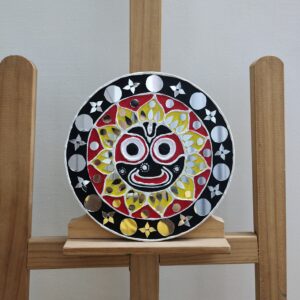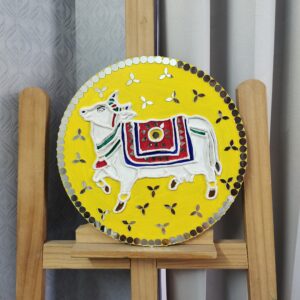Ganesha And Laxmi Aipan Original Painting
The Kumaon region of Uttarakhand, India, is home to the ancient painting technique known as “Aipan art,” which is ingrained in the region’s spiritual and cultural fabric. Aipan art, which is different in style and technique, is sometimes referred to as Alpana in Bengal or Rangoli in other regions of India. It is mostly a ceremonial art form that is widely utilized for religious events, festivals, and cultural festivities. Its distinctive style, which combines red background with elaborate white patterns, perfectly encapsulates Kumaoni spirituality and culture.
The history of Aipan art is extensive and spans many centuries. It is an essential component of Kumaon culture and daily life, usually performed by women. The term “arpan,” which means “to offer,” is the basis of the name “Aipan,” indicating the art’s profound ties to religious and devotional rituals. These paintings are thought to be lucky charms that ward off bad luck and provide good prosperity.
Major Hindu holidays like Diwali, Holi, and Navratri, as well as important life events like marriages and births, are occasions when apeipan art is frequently produced. Typically, the drawings are made on walls, floors, courtyards, and ceremonial artifacts such as the “Chowki,” a wooden platform used in religious rites. The metaphorical use of the art form emphasizes its function in calling out divine favors and establishing a hallowed area for celebration and prayer.
Simple techniques and the use of natural materials are characteristics of Aipan art. Traditionally, “Geru,” a locally produced red clay or ochre combined with water, is put to the surface to create the red background. A paste consisting of rice flour and water is used to make the white patterns. Artists create the designs, which include geometric patterns, floral themes, and symbolic depictions of gods and celestial bodies, with their fingers, a piece of cloth, or a twig.
Aipan art is made through a meditative process that calls for accuracy and imagination. The Geru base is first prepared by the artist and then let to dry. When the surface is prepared, the artist meticulously sketches the designs, working methodically outward from the center. The resulting artwork is intricate and sophisticated, despite the simplicity of the tools and materials.
Aipan art includes a vast variety of patterns, each with a unique metaphorical interpretation. Typical motifs consist of:
Geometric Patterns: These consist of squares, triangles, and circles that are frequently placed in repeating, symmetrical patterns. These designs stand for both the cyclical nature of life and the universe.
Floral Designs: Symbolizing purity, beauty, and the divine feminine, flowers like lotuses and other floral themes are frequently employed.
Deities and Sacred Symbols: Hindu deities like Ganesha, Lakshmi, and Shiva are frequently shown in aipan designs, along with symbols like the Sun, Om, and Swastika. These are said to call for safety, wealth, and spiritual health.
Footprints and Thresholds: To welcome prosperity into a home, the footprints of deities, particularly Lakshmi, the goddess of riches, are drawn at doors.
Every design in Aipan art conveys a tale that relates tales of mythology, legends, and religious beliefs in addition to being a visual feast.
As part of initiatives to conserve and promote traditional Indian crafts, there has been a resurgence of interest in Aipan art in recent years. To ensure that this cultural legacy survives, numerous efforts have been made to record and instruct younger generations in Aipan practices.
Aipan motifs are being incorporated by current designers and artisans into fashion and home décor. To introduce Aipan art to a wider audience, both in India and beyond, workshops and exhibitions are being arranged.
Aipan art is facing difficulties because of modernizing pressures and the deterioration of traditional methods, even with the growing interest in it. The transmission of Aipan methods has decreased as a result of newer generations moving to cities in pursuit of better possibilities. Furthermore, the originality and integrity of traditional Aipan art are in danger due to the availability of commercial substitutes such synthetic paints and printed designs.
But there is hope thanks to committed artists, cultural institutions, and government programs aimed at bringing Aipan art back to life and promoting it. In an effort to guarantee the survival of this exquisite and important art form, venues for artists to exhibit their work are being developed, as is the incorporation of Aipan art into academic programs.
The deep-rooted symbolism and elaborate designs of Aipan art attest to the region’s rich cultural legacy in Kumaon. The fact that it is still practiced and that revival efforts are being made of it demonstrate how traditional crafts are flexible and resilient in the face of change. Aipan art is still a dynamic and significant tradition that links the past with the present and enhances India’s cultural tapestry, even as it finds new forms and audiences.







Reviews
There are no reviews yet.